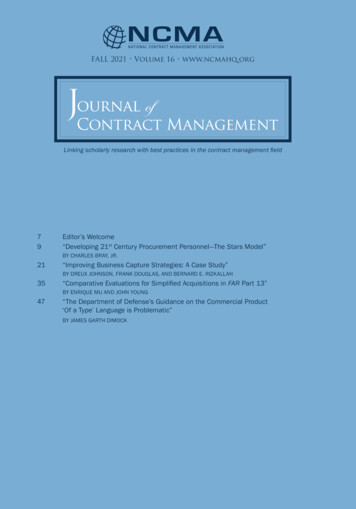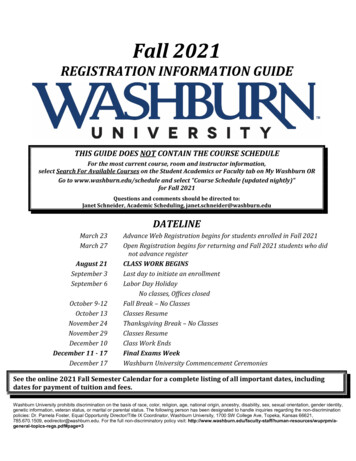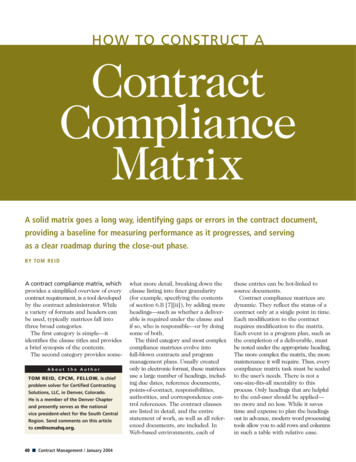
Transcription
FALL 2021 Volume 16 www.ncmahq.orgJournal ofContract ManagementLinking scholarly research with best practices in the contract management field79Editor’s Welcome“Developing 21st Century Procurement Personnel—The Stars Model”BY CHARLES BRAY, JR.21“Improving Business Capture Strategies: A Case Study”BY DREUX JOHNSON, FRANK DOUGLAS, AND BERNARD E. RIZKALLAH35“Comparative Evaluations for Simplified Acquisitions in FAR Part 13”BY ENRIQUE MU AND JOHN YOUNG47“The Department of Defense’s Guidance on the Commercial Product‘Of a Type’ Language is Problematic”BY JAMES GARTH DIMOCK
JOURNAL OFCONTRACTMANAGEMENTSTAFFJOURNAL OF CONTRACT MANAGEMENT EDITORIAL BOARDDr. Mindy Connolly, CPCM,CFCM, FellowDr. Timothy G. Hawkins,CPCMDr. Etta Waugh, CFCM,CPCM, PMPEDITOR-IN-CHIEFDr. Rene G. Rendon,CPCM, CFCM, CPSM,PMP, FellowDr. Mike Criss, CPCM,FellowDr. Michael Jennings,CPCM, CFCM, CCCM,FellowDr. Rita L. Wells, CPCM,FellowMANAGING EDITORAnna McGarityDr. Daniel Finkenstadt,CFCMCOPY EDITORDiane PlattDr. Stephen B. GordonDr. David CreedDr. Jenny J. LimJanie Maddox, CPCM,FellowDr. Michael Santens,CPCM, PMP, FellowART DIRECTION ANDDESIGNTop Shelf Design2020–2021 NCMA BOARD OF DIRECTORSNCMA PRESIDENTAmanda Christian,FellowCACIPAST-PRESIDENTMelissa StarinskyPRESIDENT-ELECTWendy MasielloWendy Mas Consulting LLCDIRECTORSDenyce CarterGeneral AtomicsIris CooperNorth Carolina Departmentof Health and HumanServicesHeather Dallara, CFCM,FellowPAEPatrick FitzgeraldBaker Tilly Virchow Krause,LLPTed HarrisonTechnical and ProjectEngineering, LLC (TAPE)Maj. Gen. CameronHoltThe Office of the AssistantSecretary of the Air Forcefor Acquisition, Technology,and LogisticsJeffrey Napier, CPCMMAP BrowardSteven Sarris, CPCMBall Aerospace andTechnologies Corp.Joy WhiteSpace and MissileSystems CenterMichael WootenNational Industries forthe BlindEX OFFICIOSNCMA CHIEF EXECUTIVEOFFICERKraig Conrad, CTP,CAENCMA General CounselJack G. Horan, JDFaegre Drinker Biddle &Reath LLPNCMA Chief FinancialOfficer and Board ofDirectors TreasurerKeith Litrenta, CPABoard of DirectorsSecretaryMonica PuckettDr. John B. Wyatt III, FellowE. Cory Yoder, MA, MS
Fall 2021 Volume 16 www.ncmahq.orgJournal ofContract ManagementLinking scholarly research with best practices in the contract management field
The Journal of Contract Management is an annual refereed journal published by the National Contract Management Association (NCMA),21740 Beaumeade Circle, Suite 125, Ashburn, Virginia 20147 (Tel: 800-344-8096; Fax: 703-448-0939). Members of NCMA receive theJournal of Contract Management as part of annual dues.The views and opinions expressed herein are solely those of the authors, not their organizations or agencies, and do not represent the viewsand opinions of the National Contract Management Association. All weblinks found within articles were deemed as valid references and werefunctional at the time of each article’s acceptance for publication.For more information on the Journal of Contract Management, including information on submitting a manuscript for consideration for publication in the Journal, please visit t-management.Copyright 2021, National Contract Management Association.
Contents7Editor’s Welcome9“Developing 21st Century Procurement Personnel—The Stars Model”BY CHARLES BRAY, JR.21“Improving Business Capture Strategies: A Case Study”BY DREUX JOHNSON, FRANK DOUGLAS, BERNARD E. RIZKALLAH AND ABDELRAHMAN ABDELHAQ35“Comparative Evaluations for Simplified Acquisitions in FAR Part 13”BY ENRIQUE MU AND JOHN YOUNG47“The Department of Defense’s Guidance on the Commercial Product‘Of a Type’ Language is Problematic”BY JAMES GARTH DIMOCK
Editor’s WelcomeNCMA is pleased to present the 2021 issue ofthe Journal of Contract Management (JCM). Since1966, the JCM (originally called the NationalContract Management Journal) has been supportingNCMA’s mission of advancing the contractmanagement profession through advocacy and theexecution of programs to connect NCMA membersand enable their professional development. Specifically, the JCM does this by publishing researchaimed at expanding the contract management bodyof knowledge, serving both the buying and sellingcommunities of the private and public sector. TheJCM scope spans a wide-range of topics in thecontract management field. It strives to comprehensively cover the contract management body ofknowledge by publishing conceptual, empirical, andpractice-based application research that demonstrates substantial conceptual development, appropriate methodology, proven-best practices, andvalue-added topics.We hope that the JCM will promote and fosterdiscussion of both theory and practice across theContract Management Body of Knowledge(CMBOK) competencies. To this end, the JCMbrings together key theory and practice applications,making the research available not only to theacademic community but also to the private andpublic sector buying and selling communities.The JCM seeks research on both cutting-edgetheories and practice applications in areas impactingthe contract management profession. We invite bothacademics and practitioners to contribute to andread the JCM.The JCM uses a double-blind peer-review process.Neither the authors nor the reviewers are madeaware of each other’s identity during the manuscriptreview process. This approach removes potentialbiases in the review process, thereby retaining qualityand objectivity. The authors submit manuscripts withfindings based on their own perspective, and theblind peer reviewers provide comments related to thequality, impact, and technical accuracy of theresearch.This year’s issue contains four peer-reviewed articlescovering a range of contract management topics. Inthe first article, “Developing 21st Century Procurement Personnel– The Stars Model,” Charles Brayintroduces a procurement staff development modelderived from phenomenological research synthesizedwith a literature review. His research shows that staffdevelopment frameworks and tools can add value toprocurement leaders by providing an outline to alignstaff development with personal and organizationalneeds. He also finds that transformational leadership and emotional intelligence characteristics aidstaff development, employee engagement andretention.The second article “Improving Business CaptureStrategies: A Case Study,” Dreux Johnson, FrankDouglas, Bernard Rizkallah, and AbdelrahmanAbdelhaq present a case study focused on a servicedisabled, veteran-owned small business. The caseidentifies evidence-based methods to improve thesmall business government contract businessdevelopment (BD) win rate and ensure its sustainability. Using the lens of systems theory, the authorsexplain the concerns of the small business government contractor, identifying overarching themes,and developing recommendations for the smallbusiness government contractor to improve itsbusiness development capabilities.The third article is authored by Enrique Mu andJohn Young and is entitled “Comparative EvaluaJournal of Contract Management / Fall 20217
EDITOR’S WELCOMEtions for Simplified Acquisitions in FAR 13.” In thisarticle, the authors first present an actionabledefinition of comparative evaluation for FAR Part13 Simplified Acquisition Procedures. They then usethe Analytic Hierarchy Process multi-criteriadecision-making methodology for the practicalimplementation of FAR Part 13 comparativeevaluations.The fourth article authored by James Dimock isentitled “The Department of Defense’s Guidance onthe Commercial Product “Of a Type” Language isProblematic.” In this article, Dimock argues that theDepartment of Defense’s guidance that the “of atype” language allows for a product to be deemedcommercial based on sales or offers of “similar to”products is misaligned with the Federal AcquisitionRegulation. He further states that DOD’s positioncreates a framework that places both DoD andindustry buyers at a disadvantage when negotiatingprices on single and sole source procurements. Hefinds that DoD’s guidance deviates from theregulation and often forces buyers to rely onimprecise and less reliable approaches to establishingprice reasonableness.As you can see from the above description of thesearticles, the JCM covers a wide-range of topics inthe Contract Management Body of Knowledge(CMBOK). This JCM issue would not have beenpossible without the support of our editorial boardand their volunteer efforts in conducting themanuscript reviews. I would like to thank theeditorial board members for taking the time out oftheir busy schedules to perform the reviews of thesemanuscripts. I sincerely appreciate the sharing oftheir time and expertise to ensure that the Journal ofContract Management continues as the top contractmanagement journal for both scholars and practitioners across the globe.Dr. Rene G. Rendon, CPCM, CFCM, FellowEditor in ChiefJournal of Contract Management8Fall 2021 / Journal of Contract Management
Developing 21Century ProcurementPersonnel– TheStars ModelstBY D R . C H A R L E S B R AY, J R .AbstractPurpose: Introduce a procurement staff development model derived from a literature review andempirical research.Design/Methodology/Approach : Phenomenological research synthesized with literaturereview.Findings: Transformational leadership andemotional intelligence characteristics aid staffdevelopment, employee engagement, and retention.Staff development frameworks and tools can addvalue to procurement leaders by providing anoutline to align staff development with personal andorganizational needs.Research Limitations/Implications: Samplesize of 15 limits generalizations; additional researchis needed.Practical Implications: Framework and toolscan help leaders manage varied staff needs acrossmultiple generations and growth needs.Originality/Value: Research synthesizesfoundational research with practitioner experienceto craft unique staff development model.Keywordstalent development, employee engagement, procurement talent development, learning and development,transformational leadership, stars staff developmentmodel, emotional intelligenceContract Management Body ofKnowledge (CMBOK )Competencies:1.0 Leadership7.0 LearnAbout the AuthorDR. CHARLES E. BRAY, JR. is Manager of the SmallBusiness Program Office at Jet Propulsion Laboratory.As a diversity, equity, and inclusion professional, Brayhas more than 20 years of experience as a leader andconsultant. Charles is a part of several teams at JPL,examining how to foster greater levels of diversity andinclusion at the Lab. He also designed and implementedSouthern CA Edison’s Supplier Develop Program ( 4Bannual spend). Bray is a Project Management Professional and has a Balanced Scorecard certification fromKaplan & Norton. Charles received his BS in ElectricalEngineering from Purdue University and his MBA fromHarvard Business School. He received his Doctorate inEducation in Organizational Leadership from Pepperdine University. He is currently pursuing a PhD in GlobalLeadership and Change.Journal of Contract Management / Fall 20219
DEVELOPING 21 ST CENTURY PROCUREMENT PERSONNEL– THE STARS MODELAn effective procurement strategy positively affectsthe ability of a company to drive profitabilitythrough its supply chain (Mena et al. 2018).However, over half of the 504 leaders surveyed inthe Deloitte Global Chief Procurement OfficerSurvey did not believe their teams had the requisiteskill to execute their company’s procurementstrategy (Umbenhauer et al. 2018). Specifically,respondents cited talent deficiencies in leadership,innovation, and digital transformation. Also, thechief procurement officers felt their organizationswere less proficient in pioneering change, inspiringothers, and talent development (Umbenhauer et al.2018). Industry experts are making an effort toaddress the talent development gap. However, theirefforts to do so are inconsistent (Harrington 2015;Umbenhauer et al. 2018).While other industry pundits cite adequate staffpreparation in data analytics and process control,they also note gaps in soft skills and emotionalintelligence (Harrington 2015; Ruamsook andCraighead 2014). Ruamsook and Craighead (2014)elaborate and describe a perfect storm of talentdeficiencies, increased demand for supply chain staff,and a shortage of supply chain instructors ascontributors to the scarcity of qualified procurementpersonnel. Other writers also detail a shortage ofqualified supply chain personnel. Gravier (2017)theorizes that the talent shortage emanates frompoor talent management strategies rather than ascarcity of talent. Gravier (2017) notes that millennials have a greater need for personal engagementwith the corporate vision to maximize involvementand productivity. Cecere (2014) says the mostsignificant gap in the supply chain talent pipeline isin developing existing employees, followed bydeficiencies in middle management, followed by askill gap for entry-level workers. Christopher (2016)cites the difficulty firms have in developing teamswith the requisite breadth of skill and flexibility tomeet today’s supply chain challenges.In summary, multiple industry writers discuss thegap in skill level of supply chain personnel, including procurement staff. The gap has the potential toimpact supply chains adversely and, thus, businessperformance for companies worldwide. Leadingfirms seek to leverage their procurement activities todrive competitive advantage and outperform their10Fall 2021 / Journal of Contract Managementcompetitors (Pettey and van der Meulen 2018;Umbenhauer et al. 2018). Therefore, companiesmust actively develop personnel to execute theirsupply chain and procurement strategies in supportof organizational objectives.Current Efforts to Address theProcurement Talent GapIndustry literature proposes several solutions toaddress the need to develop a more robust cadre ofqualified procurement personnel. Deloitte Consulting suggests that organizations implement digitalprocurement strategies to demonstrate alignmentwith millennials’ desires to stay abreast of the latesttrends, including digitization, the development ofstrong supervisors in procurement, and increasedorganizational investment in learning (Umbenhaueret al. 2018). Umbenhauer et al. (2018) also mentiontalent identification, focused staff engagement, andskill optimization as other vital elements to addressthe talent gap. Gravier (2017) implies that companies need to implement a talent developmentstrategy inclusive of worker alignment with thefirm’s vision and message. In Supply Chain Insights,Cecere (2014) cites the importance of a greateremphasis on employee career planning and workingto make supply chain planners feel valued as part ofthe talent development and retention strategy. Inaddition, Cecere (2014) proposes focused efforts byhuman resources in the areas of job design andtalent development to fill the skill gap. Harrington(2015) recommends expanded learning anddevelopment opportunities, and an “employer ofchoice focus” (p. 11) to help companies retain staffand be “an attractive place to work” (p. 11). Clark(2016) suggests firms and universities collaborate toengage youth interest in supply chain careers to fillan early stage of the talent pipeline.In summary, research highlights the impact ofinvestment, staff engagement, job design, andleadership on talent development and retention.Digital transformation factors (Umbenhauer et al.2018), engagement (Umbenhauer et al. 2018),leadership style (Ghasabeh et al. 2015), and the workenvironment (Harrington 2015) all play essentialroles in developing and retaining talent. Firms thatactively work to develop their procurement staff as a
DEVELOPING 21 ST CENTURY PROCUREMENT PERSONNEL– THE STARS MODELbusiness practice will improve the company’s overallperformance by addressing the staff developmentalneeds. Alignment of personal values with a company’s strategic vision, mission, and ethics will alsoaid employee development and company performance (Gravier 2017; Kahn 1990).The STARS Staff Development Model–One Approach to Addressing the TalentGapInformed by a phenomenological study of procurement leaders and a literature review on emotionalintelligence, transformational leadership, andemployee engagement, this article proposes a stafflearning and growth model that may aid practitioners in their efforts to develop employees. TheSystems, Technical, Availability, RelationshipManagement, and Self-Actualization (STARS) staffdevelopment model blends findings from peerreviewed research and a study of how today’sprocurement leaders develop personnel into a toolfor use by managers. The model may be useful toleaders from other disciplines as well in their effortto build the skill level of their teams. The theoreticalframework of the study, the research design, andstudy results are discussed in the following sections.Theoretical Framework--What TheoriesSupport the STARS Approach?What will help procurement leaders developappropriately skilled employees to meet supply chainchallenges in the 21st century? How can leadersdevelop staff with a healthy blend of both technicaland interpersonal skills? As noted earlier, someindustry experts and leaders note staff shortcomingsin soft skills, emotional intelligence, and digitaltransformation. Other sources cite the importanceof talent development efforts that include workerpersonal alignment with the company’s vision; agreater emphasis on employee career planning; andexpanded learning and development opportunities.As part of a study to understand and addressprocurement staff development needs, the authorblended concepts, including adult learning, transformational leadership, emotional intelligence, andemployee engagement, to craft a theoreticalframework. An overview of these theories appearsbelow.In their work on adult learning, Knowles et al.(2015) note that “andragogy works best in practicewhen it is adapted to fit the uniqueness of thelearner and the learning situation” (p. 72). According to Knowles et al. (2015), adult learners characteristically are practical seekers of relevant information who are goal-oriented, internally motivated,and who leverage life experiences to frame learning.Based on Knowles et al.’s (2015) assertion, bothlearner characteristics and their situations requireconsideration in developing a suitable developmental approach or plan. Similarly, Bass and Avolio’s(1994) notion of individual attention as a component of a transformational leadership style issynergistic with crafting an approach to fit theuniqueness of a learner.As defined by Bass and Avolio (1994), transformational leadership includes inspirational motivation,idealized influence, intellectual stimulation, andindividual consideration. In summary, effectiveleaders motivate and inspire followers in partthrough personal example; challenging assignments;and crafting of work roles and tasks to leverage theunique attributes of individuals (Bass and Avolio1994). Kahn (1990) discusses the idea that employees are psychologically engaged at work to varyingdegrees, expressing their authentic selves in theirwork roles with a presumed impact on performance(Bailey et al. 2017). Kahn’s 1990 article on workroles “describes and illustrates three psychologicalconditions–meaningfulness, safety, and availability”(Kahn 1990, 692). Leaders have a direct influenceon employees’ work roles and their job environment,thereby impacting the psychological conditionsaffecting performance. In his work, Maslowcrystalizes the concept of need fulfillment andpersonal involvement in work and other activities(Maslow, 1943). From transformational leadership,Maslow’s work, and employee engagement literature,the author derives that transformational leaders helpto create psychological conditions at work leading tohigher levels of employee engagement. Lee et al.(2011) note that the elements of transformationalleadership affect team satisfaction, competence, andlevels of performance.Journal of Contract Management / Fall 202111
DEVELOPING 21 ST CENTURY PROCUREMENT PERSONNEL– THE STARS MODELAs noted in the paragraph above, the ability toinfluence and inspire others (idealized influence andinspirational motivation) are elements of a transformational leadership style. Similarly, both of theseelements are components of the relationshipmanagement domain of emotional intelligence(Goleman 2018; Hay Group 2011). According toGoleman (2018), the four domains of emotionalintelligence are self-awareness, self-management,social awareness, and relationship management.These four domains consist of 12 competencies. Twoof the four domains–social awareness and relationship management–tie directly to a transformationalleadership style inclusive of empathy towardindividuals, organizational awareness, influence,and inspirational leadership. Transformationalleaders discern and connect with factors thatmotivate employees and help them to engage andbuy into the company’s or leader’s vision for theirjob role (Bass and Avolio 1994). Leadership style hasan effect on workers and the organization throughempathy, influence, inspiration, and relationshipmanagement (Bass and Avolio 1994). Goleman’swork is consistent with earlier work by Salovey andMayer (1990), which laid out a three-level conceptualization of emotional intelligence. The authorconcludes that emotional intelligence is an essentialcomponent of leadership effectiveness and anecessary factor in successful staff development.Literature from Gallup Research (Harter et al.2010; Harter et al. 2016) on employee engagement,and writings from other foundational authors(Hackman and Oldham 1980; Herzberg 1968;Maslow 1943) on job design, motivation, andpersonal fulfillment, also touch upon the importance of leadership to individual and organizationalperformance. In summary, the theoretical framework for this article is a blend of several intersectingconcepts developed and elaborated on by multipleresearchers over the decades. As illustrated above,theories, including adult learning, transformationalleadership, emotional intelligence, employeeengagement, job design, motivation, and personalfulfillment, are relevant considerations in staffdevelopment. The theoretical framework cited aboveincorporates phenomenological research on staffdevelopment practices of current procurementmanagers. The research questions from the phenomenological study appear in the following section.12Fall 2021 / Journal of Contract ManagementResearch on Current ProcurementStaff Development PracticesIn addition to the literature review, a research studyemployed the phenonmenological methodology tointerview fifteen procurement leaders to leverage thesubjects’ experiences to develop insight into theirstaff development efforts (Moustakas 1994). As apost-positivist constructivist, the author believesindividuals frame their worldview based on personalperceptions (Kubálková 2019). Therefore, the authoracknowledges that his interpretive lens, as well asthe perspectives of the interviewees, may haveintroduced bias into the analysis. Therefore, theauthor factored the appropriateness, strength, andweakness of the phenomenological approach intothe research design to optimize the validity andreliability of the study. A succinct outline of theauthor’s worldview, study’s goals, and methodologyappear as the theoretical framework shown in Table1 below.TABLE 1: RESEARCH THEORETICAL FRAMEWORKElementDescriptionsResearcher WorldViewPost-positivist, constructivist–Subjects construct reality frompersonal perspectives.Research GoalsUnderstand current procurementstaff development practices; tieinto literature; gain insight intoeffective staff eralqualitative inquiry–supported byliterature review.
DEVELOPING 21 ST CENTURY PROCUREMENT PERSONNEL– THE STARS MODELThe primary tool for the phenomenological researchwas the use of research questions, and corresponding semi-structured interview questions, to obtainthe subject’s perspectives. There were four researchquestions and 12 relevant interview questions. Theresearch questions and the corresponding interviewinquiries are shown in Table 2 below.TABLE 2: RESEARCH AND INTERVIEW QUESTIONSElementDescriptionsRQ1: What strategies and practicesdo current purchasing managersuse to develop employees?IQ 1: What strategies and practices do you use to develop employees?IQ 2: What steps do you take to implement your strategies and practices todevelop employees?IQ 3: What additional elements do you use?RQ2: What challenges dopurchasing managers face in theirefforts to develop employees?IQ 4: How do you manage the biggest challenges in developing employees?IQ 5: How do you overcome employee resistance to your efforts?IQ 6: Did anything go wrong you had not anticipated?RQ3: How do purchasing managersmeasure and track success indeveloping employees?IQ 7: What are the top metrics you track to measure success in developingemployees? (limit them to 3-5 if they went long)IQ 8: What outcome(s) are you willing to accept?IQ 9: What assistance does your organization give you in measuring and trackingemployee development?IQ 10: What factors would you like to measure and track but are unable to do so?RQ4: What recommendationswould current purchasingmanagers give the futuregeneration of leaders in developingemployees?IQ 11: What lessons have you learned in employee development we have notcovered in this interview?IQ 12: What would you not do-over?The research subject population was from SouthernCalifornia chapters of procurement memberorganizations, including the Institute for SupplyManagement (ISM), the National ContractsManagement Association (NCMA), and theInstitute for Public Procurement (NIGP). Interviewswith fifteen subjects occurred. The study employedpurposive sampling, and included only procurementmanagers with at least two years’ experience in asupervisory role, who were active in personnelmanagement and development, with purchasingbudgets ranging from 20 million to 13 billionannually.ResultsCommon themes across the participants began toemerge during the data analysis. Fifteen participantinterviews provided sufficient evidence of datasaturation (Saldaña 2015). The findings distill thetalent development practices of procurementmanagers interviewed. Themes for each researchquestion appear separately. A few themes fit underother topics but appear separately to provide greaterinsight into the participants’ perspectives and toalign with knowledge gleaned from the literaturereview. A summary of the themes from participantanswers to the research questions is given in Table 3on page 14.Journal of Contract Management / Fall 202113
DEVELOPING 21 ST CENTURY PROCUREMENT PERSONNEL– THE STARS MODELTABLE 3: SUMMARY OF THEMES FOR FOUR RESEARCH QUESTIONSRQ1RQ2RQ3RQ4Transformational LeadershipProviding EffectiveFeedbackPerformance AgainstCompany StandardsGive Timely and CandidFeedbackEmotional IntelligenceManaging DisciplineIssuesCustomer Service andCommentsBe Servant LeadersTechnical Skill TrainingTransformationalLeadershipPromotionsEngage EmployeesResources and Tools Such asIDPsProvide Better CoachingEQ Growth of StaffSet an Example and ShowEmpathyCoachingEmployee EngagementProgress TowardDevelopmental Goals/Qualitative MeasuresLeverage LeadershipConceptsFeedbackTrainingSelf-Generated Performance MetricsAttend TrainingMentoringLeveraging the RightLeadership ConceptIDPs, Reports, and OtherToolsEmotional SafetyResource Management(Time)Training AttendedOther Leadership ConceptsSuch as Crucial ConversationsManaging ChangeEmployee EngagementSuccession PlanningManaging out UnderperformersWork-Life BalanceGenesis of the STARS StaffDevelopment ModelFrom the literature review and interviews, practiceson “How” leaders approach staff development andthe “What” skills/content they leverage becameapparent. Based on the analysis, the STARS modeladdresses both content and approach based oncareer stage. “How” leaders approach staff development centered on leadership style, emotionalintelligence, and efforts to provide meaningful workin a psychologically safe, constructive environment.“What” leaders center on information technology,job specific technical skills, and soft skills. The“What” of staff development varied based on careerstage.14Fall 2021 / Journal of Contract ManagementIn summary, each leader interviewed had a definiteleadership style and a personal approach on how todevelop staff. However, not all leaders had aconsistent framework through which to categorizewhat staff development topics were most relevant foremployees. Some leaders spoke of a general framework leveraging the employee annual performanceevaluation from human resources and curriculaprovided by industry associations. Other leadersfound the yearly performance evaluation lackingand the categorization of developmental contentfrom industry groups too limited for mid andlate-career staff development. Some leaders relied onself-developed frameworks or Individual Development Plans (IDPs). All leaders interviewed recognized the need to approach staff developmentthoughtfully.
DEVELOPING 21 ST CENTURY PROCUREMENT PERSONNEL– THE STARS MODELGiven the variation in the use of developmentalapproaches and the leader’s additional comments onstaff engagement, the researcher leveraged components from both the interviews and the literaturereview to create a staff development model. Themodel addresses both the “How” to approach staffdevelopment and the “What” of content. Ultimately,the model is a tool that facilitates the creation of acustom, organization-specific staff developmentapproach around a relevant set of topics. A procurement leadership team could use the model toquickly outline the content in each area, withlimited support from their human resourcesdepartment. Using the model, a two-hour brainstorming session with specific deliverables shouldyield actionable results for most teams. Th
Jeffrey Napier, CPCM MAP Broward Steven Sarris, CPCM Ball Aerospace and Technologies Corp. Joy White Space and Missile Systems Center Michael Wooten National Industries for the Blind EX OFFICIOS NCMA CHIEF EXECUTIVE OFFICER Kraig Conrad, CTP, CAE NCMA General Counsel Jack G. Horan, JD Faegre Drinker Biddle & Reath LLP NCMA Chief Financial










